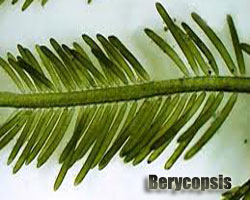Berycopsis

Science Name
Polymixiidae
Description
Its pectoral fins were placed high on the side of the body, to better control steering and braking, the pelvic fins had moved for- ward, to counterbalance the pectorals. Berycopsis' body had a lightweight coat of thin, rounded scales, their surfaces made abrasive by tiny, comblike teeth. And its swim bladder was no longer connected to the throat, and the fish relied on the bladder's own gas- secreting and absorbing glands to make it neutrally buoyant.
Habitat
It was about 35 centimetres (14 in) long and one of the first members of the Acanthopterygii, the group that includes the present day barracuda, swordfish, seahorses, and flatfish.
Behaviour
The first fin ray in the dorsal and anal fin was enlarged into a stout spine, which could be erected for defense .
Life History
Berycopsis was one of the earliest spiny- rayed teleosts (the acanthopterygians) to appear.Today, this group, with an evo- lutionary history of some 70 million years, is the most successful and varied of all bony fishes, accounting for 40 percent of living species. They range from barracuda and swordfish,to perch, tropical reef fish, flatfish and seahorses.
Region Found
Europe (England)
 Deep Sea Crabs
Deep Sea Crabs